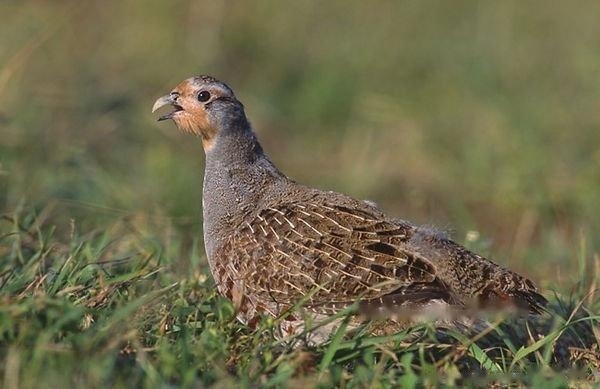The grey partridge (scientific name: Perdix perdix) is a bird of the genus Partridge in the Phasianidae family. Distributed in Europe, Asia (from the Ural Mountains in the west, the western Sayan Mountains in the east, the Ob River Basin in the north, Iran in the south, and Xinjiang in mainland China, etc.) Alder alder in highlands, in groves by rivers or lakes, in mountainous fields, and near rural areas. The species is type-localized in Sweden.

[shape features]
Grey partridge The grey partridge is about 300 mm in length.
Male bird, upper body gray-brown, with dark brown irregular dense stripes and light chestnut horizontal spots. The head and pillow feathers are dark brown, with Brown-yellow feather dry pattern; light-colored pattern on eye; ear feathers dark brown; flight feathers and upper wing coverts dark brown, scattered with brown-white and brown-yellow horizontal spots; central tail feathers brown, with black-brown horizontal spots and wavy fine spots ;The outer tail feathers are maroon with brownish-white end spots; the underparts are nearly white; there are horseshoe-shaped chestnut patches on the lower chest; But no chestnut spots.
Iris-brown; Mouth-near yellow; Feet-yellow.
【Life habits】
Grey partridge Quail inhabits various habitats such as low mountains and hills, foot plains and high mountains. In summer, it is mostly in high mountains and rocky slopes, plateau grasslands with sparse trees and shrubs, or in valleys at the foot of mountains, rivers, lakeside bushes and mountain fields. In other habitats, they often go to the foothills and plains, farmland, and threshing fields or haystacks near villages in winter. They often live in groups except during the breeding season. Either family groups or larger groups composed of family groups . Usually in groups of 5-15 birds.
The males have a quacking sound, like ki-errr-ik, ki-errr-ik, with an emphasis on errr. Lively temperament, good at running and hiding. Low grrree-grrree call when driven. Fly fast and in a straight line, but usually falls into grass or bushes on the ground after a short distance. Often high-pitched call when taking off. Does not fly high, often close to the ground In flight, the wings flap quickly and make a clear flapping sound.
Mainly feed on plant foods such as twigs, young leaves, buds, flowers, fruits, seeds and other plant foods of herbs and shrubs. Eating crops such as grains, especially in autumn and winter, often foraging in farmland, in addition to eating grasshoppers, locusts, crickets and other small ridgeless propellers and insects, especially in summer. Foraging mainly in the morning and evening, mostly at noon Rest in the shade.
【Growth and reproduction】
The gray partridge has already started to call for courtship between January and February every year. Courtship performances are often performed in the early morning before the sun rises. The male bird keeps jumping up and making excited calls at the same time. The female bird keeps echoing while approaching the male bird, and then the male bird jumps on the back of the female bird to mate. Mating can continue until June. The mates are one-female and one-male. After the pairing is formed, the male and female birds leave the group in pairs.
The gray partridge nests in plains and valleys, streams, dry grasslands, young grasslands, and mountain sparse forests and thicket areas rich in shrubs and wormwood. Nests are mostly placed in tall grasses on the ground or under thickets, and there are shrubs and grasses hidden in them, which are generally difficult to find. Males and females often nest together. The structure of the nest is very simple, mainly by digging a shallow pit in the hollow of the soft ground, and padding it with hay, moss and feathers. A clutch lays 10-20 eggs, with a maximum of 26 eggs. Eggs are usually laid once a day. Eggs are grey or grey-green in colour, 32-39 x 24-29 mm in size and 9-13 g in weight. The brood is shared by the male and female, or the female broods and the male is on guard in the nesting area. Female birds have a strong nest love. The incubation period is 21-26 days, and the chicks can follow their parents on the day they hatch, and live in pairs or small families until autumn.
【Geographical distribution】
The gray partridge has a wide distribution range, almost all over Europe, from the British Isles, Scandinavia, Portugal, Spain, France And so on to the east through central Europe, east to central Asia, northern Iran and other places. But in China, it is only distributed in the Tacheng and Junggar Basins in the northwest of Xinjiang.
【Subspecies differentiation】
The northern subspecies of gray partridge gray partridge (scientific name: Perdix perdix robusta). Distributed in Siberia and Xinjiang in mainland China. The type origin of this species is in the Altai Mountains.
![[Dog Training 5] The training method of pet dog dining etiquette](/static/img/12192/12192_1.jpg)




